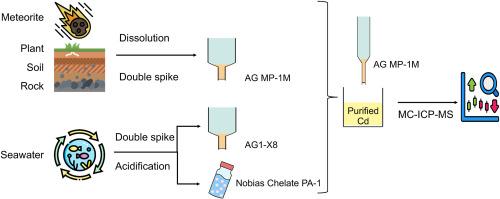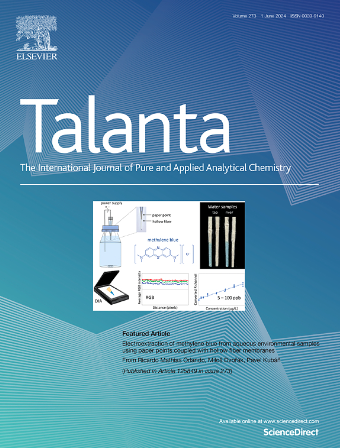采用双尖峰MC-ICP-MS对不同样品进行高精度镉同位素分析的高效镉分离方案。
IF 6.1
1区 化学
Q1 CHEMISTRY, ANALYTICAL
引用次数: 0
摘要
镉同位素分析在行星科学、地球科学、环境科学和生命科学等领域都有广泛的应用。然而,目前仍缺乏从不同类型样品中分离痕量元素Cd的有效方法。本研究提出了一种新的和改进的Cd分离和纯化技术,用于陨石、各种陆地和海水样品的Cd同位素测量,采用多收集器ICP-MS使用双尖峰方法进行质量偏差校正。陨石和陆地样品的第一个分离阶段采用现有的阴离子交换色谱法,使用AG MP-1M树脂,而AG 1-X8和Nobias Chelate PA-1树脂分别用于小样本和大样本海水样品的初始分离。然后采用聚四氟乙烯微柱和AG MP-1M阴离子交换树脂对所有样品类型进行进一步的Cd纯化。该方法比以前的方法更有效地从基体元素中分离Cd,同时实现了一贯的高Cd回收率,陨石和陆地样品的Cd回收率为95%,海水样品的Cd回收率为80%,结合Murchison陨石和普通球粒陨石GRO 95504的低程序空白(114Cd)。最后,对七个镉浓度在0.25至0.91 nmol kg-1之间的海水样本进行了分析,样品体积高达2 L,得出的结果与之前的研究一致。总的来说,新方法可以对不同类型的样品进行无偏δ114Cd测量,即使对天然Cd含量为10 ng或更少的样品,其2SD精度也优于±0.07‰。本文章由计算机程序翻译,如有差异,请以英文原文为准。

Efficient Cd separation protocols for high-precision cadmium isotope analyses of diverse samples by double spike MC-ICP-MS
Cadmium isotope analyses are applied for research in planetary, Earth, environmental and life sciences. However, there is still a lack of efficient methods for the separation of the trace element Cd from the different types of samples that are of interest for isotopic analyses. This study presents new and improved Cd separation and purification techniques for meteorite, diverse terrestrial and seawater samples prior to Cd isotope measurements by multiple collector ICP-MS using the double spike approach for mass bias correction. The first separation stage for meteorites and terrestrial samples employs an existing anion exchange chromatography method that uses AG MP-1M resin, whilst AG 1-X8 and Nobias Chelate PA-1 resins were applied for the initial isolation of Cd from small and large seawater samples, respectively. Teflon microcolumns and AG MP-1M anion exchange resin was then employed for further Cd purification of all sample types. The methods consistently isolate Cd from matrix elements more efficiently than previous protocols, whilst achieving consistently high Cd recoveries, of >95 % for meteorite and terrestrial samples and >80 % for seawater samples, combined with low procedural blanks of <0.08 ng. The performance of the new protocols is demonstrated by repeated Cd isotope analyses of well-characterized geological and biological reference materials, which produced data that are in excellent agreement with results that were obtained with previous, more laborious separation methods. Furthermore, precise Cd isotope compositions (δ114Cd) are presented for the Murchison meteorite and, for the first time, the ordinary chondrite GRO 95504. Finally, analyses of seven seawater samples, with Cd concentrations between 0.25 and 0.91 nmol kg−1 using sample volumes of up to 2 L, generated results consistent with those of previous studies. Overall, the new methods thus enable unbiased δ114Cd measurements for diverse sample types with a 2SD precision of better than ±0.07 ‰, even for samples with 10 ng or less of natural Cd.
求助全文
通过发布文献求助,成功后即可免费获取论文全文。
去求助
来源期刊

Talanta
化学-分析化学
CiteScore
12.30
自引率
4.90%
发文量
861
审稿时长
29 days
期刊介绍:
Talanta provides a forum for the publication of original research papers, short communications, and critical reviews in all branches of pure and applied analytical chemistry. Papers are evaluated based on established guidelines, including the fundamental nature of the study, scientific novelty, substantial improvement or advantage over existing technology or methods, and demonstrated analytical applicability. Original research papers on fundamental studies, and on novel sensor and instrumentation developments, are encouraged. Novel or improved applications in areas such as clinical and biological chemistry, environmental analysis, geochemistry, materials science and engineering, and analytical platforms for omics development are welcome.
Analytical performance of methods should be determined, including interference and matrix effects, and methods should be validated by comparison with a standard method, or analysis of a certified reference material. Simple spiking recoveries may not be sufficient. The developed method should especially comprise information on selectivity, sensitivity, detection limits, accuracy, and reliability. However, applying official validation or robustness studies to a routine method or technique does not necessarily constitute novelty. Proper statistical treatment of the data should be provided. Relevant literature should be cited, including related publications by the authors, and authors should discuss how their proposed methodology compares with previously reported methods.
 求助内容:
求助内容: 应助结果提醒方式:
应助结果提醒方式:


